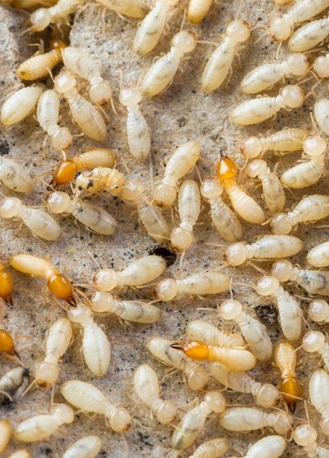Identifying termites correctly is crucial for Sydney homeowners - mistaking these destructive pests for flying ants or other insects can lead to costly property damage. Here's your comprehensive guide to recognising termites before they cause significant harm to your home.
Physical Characteristics of Australian Termites
Size and Body Structure Termites typically measure 4-8mm in length, with soft, pale bodies that lack the defined waist seen in ants. Their straight antennae and broad thorax distinguish them from other insects commonly found in Sydney homes.
Key Identifying Features:
- Soft, segmented bodies ranging from creamy white to dark brown
- Two pairs of wings (when swarming) that are equal in size
- Straight, beaded antennae
- Broad waist connecting head to abdomen
- Large heads with prominent mandibles (soldier termites)

Common Australian Termite Species
Coptotermes Species The most destructive termites in Australia, Coptotermes acinaciformis and Coptotermes frenchi are widespread across Sydney. These subterranean termites create extensive tunnel systems and can cause severe structural damage.
Cryptotermes Brevis (West Indian Drywood Termite) A smaller species that infests dry timber, often found in furniture and structural wood. These termites are harder to detect as they live entirely within the wood they consume.
Schedorhinotermes Intermedius Common in coastal areas like Sydney, these termites attack both timber structures and live trees. They're particularly active in warm, humid conditions.
The Termite Caste System - Different Appearances
Understanding termite castes helps with accurate identification:
Worker Termites
- Pale, cream-coloured bodies
- 4-6mm in length
- Rarely seen as they work inside timber
- Soft-bodied with no wings
Soldier Termites
- Larger heads with powerful mandibles
- Brown to tan colouration
- Defend the colony from threats
- Slightly larger than workers
Reproductive Alates (Flying Termites)
- Dark brown to black bodies
- Two pairs of wings of equal length
- 8-10mm including wings
- Most commonly seen during swarming season
Queens and Kings
- Queens can grow extremely large (up to 10cm)
- Rarely seen outside the nest
- Cream to brown colouration
Seasonal Appearance Patterns
Spring and Early Summer (October-December) This is when you're most likely to spot flying termites. Coptotermes species typically swarm on warm, humid evenings in October and November across Sydney.
Summer Months Other species continue swarming through summer until March. Workers remain active year-round but are rarely visible.
Signs of Termite Presence vs. Visual Identification
Since termites are secretive, you're more likely to see signs of their activity than the insects themselves:
Mud Tubes
- Brown, pencil-thin tunnels along walls or foundations
- Connect soil to timber food sources
- Active tubes feel moist inside
Frass (Termite Droppings)
- Small, dark pellets near wooden surfaces
- More common with drywood termites
- Often mistaken for sawdust
Hollow-Sounding Timber
- Tap wooden structures - hollow sounds indicate internal damage
- Timber may appear normal externally
Discarded Wings
- Found near windows, doors, or light sources
- Clear sign of recent swarming activity
- Wings are translucent and equal in size
Termites vs. Flying Ants - Key Differences
Many Sydney residents confuse flying ants with termites. Here's how to tell them apart:

| Feature | Termites | Flying Ants |
|---|---|---|
| Waist | Broad, straight | Pinched, narrow |
| Antennae | Straight, beaded | Bent, elbowed |
| Wings | Two pairs, equal size | Two pairs, unequal |
| Body Color | Pale to dark brown | Usually black |
What to Do if You Spot Termites
Don't Use DIY Sprays Disturbing termites with household insecticides causes them to retreat deeper into your property, making professional treatment more difficult.
Avoid Physical Disturbance Don't poke or prod suspected termite activity. This scares them away temporarily but doesn't eliminate the colony.
Document and Contact Professionals Take photos if possible and contact a licensed termite inspector immediately. Early detection significantly reduces treatment costs.
Monitor Flying Termites If you see winged termites inside your home:
- Close interior doors and windows
- Turn off inside lights, turn on exterior lights
- Call a termite specialist - this indicates an active infestation
Prevention Through Early Recognition
Regular visual inspections help identify termite activity before major damage occurs:
Monthly Checks
- Inspect around your home's perimeter
- Look for mud tubes on foundations
- Check for frass near timber features
- Monitor for hollow-sounding wood
Professional Inspections AS 3660.2 recommends annual termite inspections for all Sydney properties. Professional inspectors use specialized equipment to detect termites before visible signs appear.
Environmental Factors Affecting Termite Appearance
Moisture Conditions High humidity and moisture make termites more active and visible. Check areas with:
- Poor ventilation
- Leaking pipes
- Rising damp
- Garden irrigation near foundations
Seasonal Weather Patterns Sydney's warm, humid climate creates ideal conditions for termite activity. Be especially vigilant during:
- After heavy rainfall
- Humid summer evenings
- Following building renovations
Understanding what termites look like is your first line of defence against property damage. However, their secretive nature means professional termite inspections remain essential for comprehensive protection.
For immediate termite identification and treatment in Sydney, contact our experienced team. We provide thorough inspections and effective termite treatment solutions to protect your property investment.
